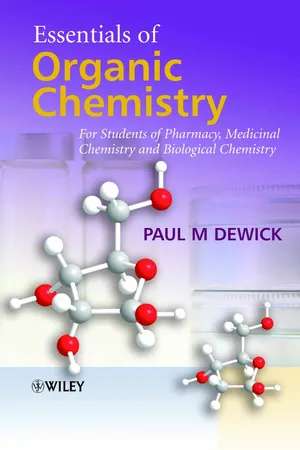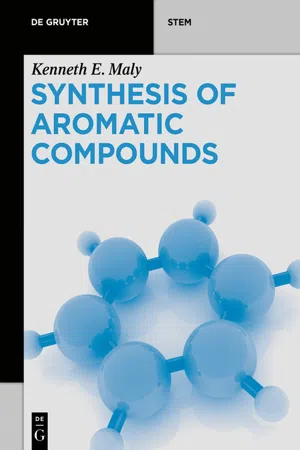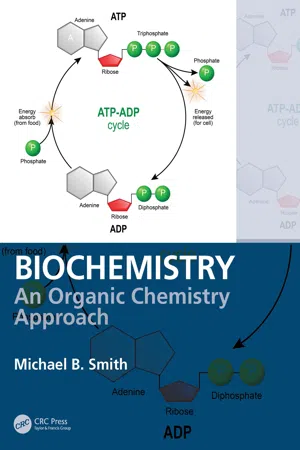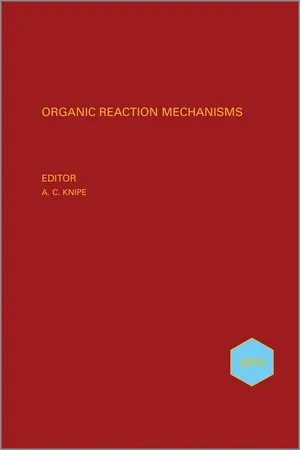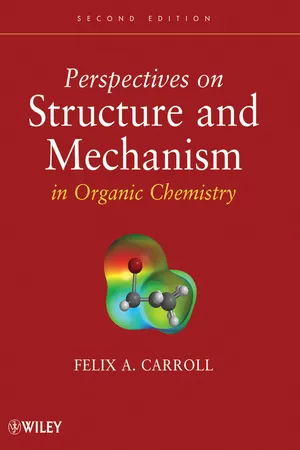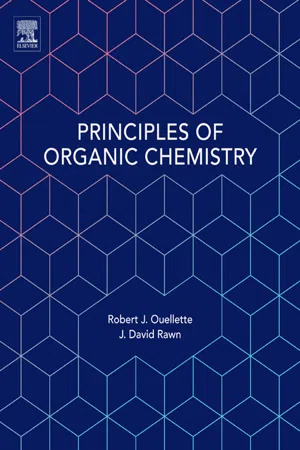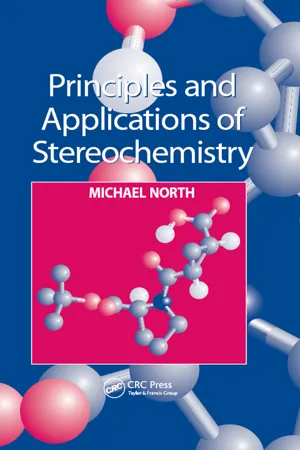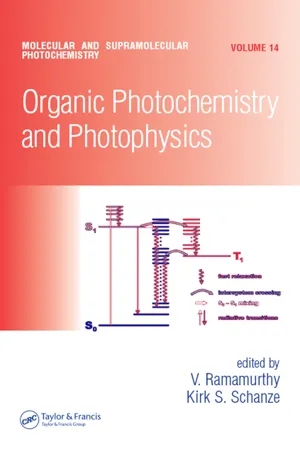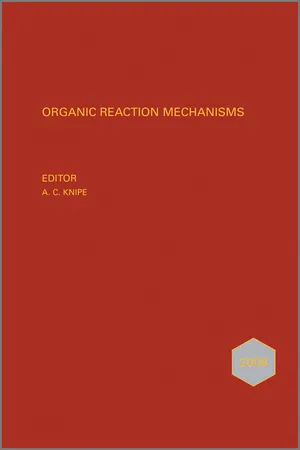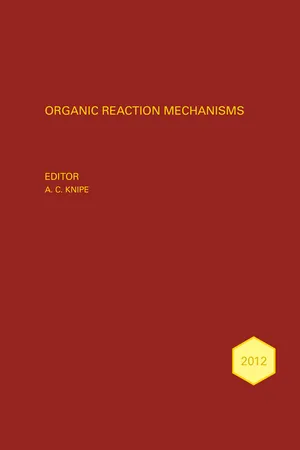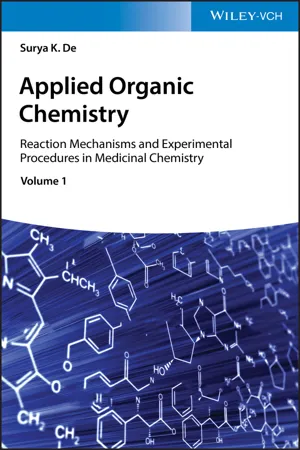Chemistry
Nucleophilic Substitution Reaction of Benzene
Nucleophilic substitution reactions of benzene involve the replacement of a substituent on a benzene ring with a nucleophile. This process typically occurs through the attack of the nucleophile on the electrophilic carbon atom of the benzene ring, leading to the formation of a new substituted product. These reactions are important in organic chemistry for synthesizing a wide range of aromatic compounds.
Written by Perlego with AI-assistance
Related key terms
Related key terms
1 of 4
Related key terms
1 of 3
12 Key excerpts on "Nucleophilic Substitution Reaction of Benzene"
- eBook - ePub
Essentials of Organic Chemistry
For Students of Pharmacy, Medicinal Chemistry and Biological Chemistry
- Paul M. Dewick(Author)
- 2013(Publication Date)
- Wiley(Publisher)
6
Nucleophilic reactions: nucleophilic substitution
As the term suggests, a substitution reaction is one in which one group is substituted for another. For nucleophilic substitution, the reagent is a suitable nucleophile and it displaces a leaving group. As we study the reactions further, we shall see that mechanistically related competing reactions, eliminations and rearrangements, also need to be considered.6.1 The SN 2 reaction: bimolecular nucleophilic substitution
The abbreviation SN 2 conveys the information ‘substitution–nucleophilic–bimolecular’. The reaction is essentially the displacement of one group, a leaving group, by another group, a nucleophile. It is a bimolecular reaction, since kinetic data indicate that two species are involved in the rate-determining step:where Nu is the nucleophile, RL the substrate containing the leaving group L, and k is the rate constant.In general terms, the reaction can be represented as belowDifferences in electronegativities (see Section 2.7) between carbon and the leaving group atom lead to bond polarity. This confers a partial positive charge on the carbon and facilitates attack of the nucleophile. As the nucleophile electrons are used to make a new bond to the carbon, electrons must be transferred away to a suitable acceptor in order to maintain carbon’s octet. The suitable acceptor is the electronegative leaving group.The nucleophile attacks from the side opposite the leaving group – electrostatic repulsion prevents attack in the region of the leaving group. This results in an inversion process for the other groups on the carbon centre under attack, rather like an umbrella turning inside out in a violent gust of wind. The process is concerted, i.e. the bond to the incoming nucleophile is made at the same time as the bond to the leaving group is being broken. As a consequence, the mechanism involves a high-energy transition state in which both nucleophile and leaving group are partially bonded, the Nu–C–L bonding is linear, and the three groups X, Y, and Z around carbon are in a planar array. This is the natural arrangement to minimize steric interactions if we wish to position five groups around an atom, and will involve three sp 2 orbitals and a p orbital as shown. The p orbital is used for the partial bonding; note that we cannot have five full bonds to a carbon atom. The energy profile for the reaction (Figure 6.1 - eBook - ePub
- Andrew F. Parsons(Author)
- 2013(Publication Date)
- Wiley(Publisher)
2 groups, respectively. This electrophilic substitution reaction (with the diazonium salt as the electrophile) produces highly coloured azo compounds.Steric effects and electrophilic substitution is discussed in Section 7.3.2.47.7 Reduction of the Benzene Ring
Harsh reaction conditions are required to reduce the aromatic benzene ring. This can be achieved by catalytic hydrogenation (using high temperatures or pressures and very active catalysts) or alkali metals in liquid ammonia/ethanol (in a Birch reduction ).Catalytic hydrogenation of alkenes and alkynes is discussed in Section 6.3.2.4Catalytic Hydrogenation
In the chair conformation of a substituted cyclohexane, the substituent (R) sits in an equatorial position (Section 3.2.4)Birch Reduction
Sodium or lithium metal (in liquid ammonia) can donate an electron to the benzene ring to form a radical anion (R√− ). On protonation (by ethanol, EtOH) and further reduction then protonation, this produces 1,4-cyclohexadiene.Addition of an electron to a neutral organic compound forms a radical anion; loss of an electron from a neutral organic compound forms a radical cation (Section 10.1.1) For a related reduction of an alkyne, see Section 6.3.2.47.8 The Synthesis of Substituted Benzenes
The following points should be borne in mind when planning an efficient synthesis of a substituted benzene.1. The introduction of an activating group on to a benzene ring makes the product more reactive than the starting material. It is therefore difficult to stop after the first substitution. This is observed for Friedel-Crafts alkylations. Activating groups donate electron density toward the benzene ring (Section 7.3.1)An alkyl group is an ortho -/para -directing activatorThe mechanism of Friedel-Crafts alkylation is discussed in Section 7.2.42. The introduction of a deactivating group on to a benzene ring makes the product less reactive than the starting material. Therefore multiple substitutions do not occur, for example, in Friedel-Crafts acylations (to give ketones, e.g. ArCOR). The ketone (ArCOR) could then be reduced to give the mono-alkylated product (ArCH2 R) in generally higher yield than that derived from a Friedel-Crafts alkylation. The mechanism of Friedel-Crafts acylation is discussed in Section 7.2.5 The Clemmensen reduction is introduced in Section 7.6 - eBook - ePub
- Kenneth E. Maly(Author)
- 2022(Publication Date)
- De Gruyter(Publisher)
3 Nucleophilic aromatic substitution reactions3.1 Introduction
In the previous chapter, we saw that aromatic rings themselves are usually nucleophiles, reacting with electrophiles in electrophilic aromatic substitution reactions. Furthermore, SN 2 reactions cannot take place at the sp2 hybridized carbon atoms of an aromatic ring. Nonetheless, as we will see in this chapter, nucleophilic displacements on aromatic rings can occur. We will explore the mechanistic scenarios for nucleophilic aromatic substitution with particular attention to the addition–elimination mechanism. We will also consider the chemistry of aryl diazonium salts, which bear superficial resemblance to nucleophilic aromatic substitution.3.2 Addition–elimination of nucleophiles (SN Ar)
The most common type of nucleophilic aromatic substitution at an aromatic ring proceeds first by nucleophilic addition to the carbon bearing the leaving group to form a delocalized carbanion intermediate, followed by expulsion of the leaving group and rearomatization [1 ]. Because the reaction proceeds by an anionic intermediate, it usually involves electron-deficient aromatic rings. The rate-determining step is typically nucleophilic addition and the reaction usually requires electron withdrawing groups ortho or para to the site of nucleophilic attack (Figure 3.1 ).Figure 3.1: Generalized SN Ar mechanism.As shown in Figure 3.1 , initial nucleophilic attack at the carbon bearing the leaving group results in a delocalized carbanion intermediate, referred to as a Meisenheimer complex. The reaction often requires electron-withdrawing groups ortho or para to the leaving group in order to stabilize the negative charge of the intermediate. The most common electron-withdrawing groups used to activate compounds toward nucleophilic aromatic substitution are nitro groups, but other frequently used groups include cyano, carbonyl, and sulfonate groups. All of these groups can stabilize the negative charge by resonance. This direct resonance stabilization explains the importance of having electron-withdrawing at the ortho- and/or para-positions – groups in the meta-positions can only stabilize the negative charge inductively. As strong support for this mechanism, several Meisenheimer intermediates have been isolated and characterized (Figure 3.2 ) [2 - eBook - ePub
Biochemistry
An Organic Chemistry Approach
- Michael B. Smith(Author)
- 2020(Publication Date)
- CRC Press(Publisher)
3 Nucleophiles and ElectrophilesAliphatic substitution reactions are early examples of organic chemical reactions in a typical undergraduate organic chemistry course. Such reactions involve the reaction of nucleophilic species with an electrophilic species, and for the most part they follow first-order or second-order kinetics. There are nucleophiles that are prevalent in biochemical reactions, including alcohols, amines, and thiols. Substitution reactions in a typical organic chemistry course involve reactions at carbon that is connected to a heteroatom moiety such as a halogen leaving group. In biochemistry the leaving group is often a phosphonate ester or another biocompatible group. Another type of nucleophilic reaction involves carbonyl compounds, including acyl addition of ketone and aldehyde moieties and acyl substitution reactions of carboxylic acid derivatives.This chapter will briefly review the SN 2 and SN 1 reactions and then describe nucleophiles that are common in biochemical applications and the substitution reactions that are common for these nucleophiles. Nucleophilic reactions require electrophilic species. Electrophiles or electrophilic substrates are common in biochemistry, including phosphonate derivatives, carbonyl compounds and imine compounds. Any discussion of typical nucleophilic reactions also requires an understanding of such electrophilic substrates. The fundamentals of both acyl addition and of acyl substitution reactions will be presented for carbonyl electrophilic centers and the reactions of these electrophilic centers with nucleophiles.3.1 Nucleophiles and Bimolecular Substitution (the SN 2 Reaction)The SN 2 reaction is one of the seminal reactions in a typical undergraduate organic chemistry course. The reaction of 1-bromo-3-methylbutane with sodium iodide (NaI) using acetone as a solvent gave 1-iodo-3-methylbutane, in 66% yield.1 In terms of the structural changes, the iodide ion substitutes for the bromine, producing bromide ion (Br– ). Iodide reacted as a nucleophile in the reaction at Cδ+ of the alkyl bromide, breaking the C—Br bond and transferring the electrons in that bond to bromine. In molecules that contain the C—Br bond, or indeed a C—C bond, where X is a heteroatom-containing group, the carbon will have a δ+ dipole. In other words, the carbon atom is electrophilic, and the substrate that reacts with the nucleophile is called an electrophile. The reaction of a nucleophile with an aliphatic electrophile is formally called nucleophilic aliphatic substitution , illustrated in Figure 3.1 . The displaced atom or group (e.g., chloride), departs (leaves) to become an independent ion. Displacement of chlorine leads to the chloride ion (Cl– ), but the bromide ion, iodide ion, or a sulfonate anion also correlates to X, which is referred to as a leaving group . In many biochemical reactions, the leaving group is a phosphate, —O–PO2 - eBook - ePub
Organic Reaction Mechanisms 2010
An annual survey covering the literature dated January to December 2010
- A. C. Knipe, A. C. Knipe(Authors)
- 2012(Publication Date)
- Wiley(Publisher)
Chapter 5 Nucleophilic Aromatic Substitution M. R. CramptonDepartment of Chemistry, University of Durham, Durham, UKGeneralThe SN Ar MechanismHeterocyclic Systems Meisenheimer and Related Complexes ReferencesGeneral
Studies of the effects of solvent composition, acidity, and temperature on the dediazoniation reactions of 4-methylbenzenediazonium ions have been reported. In ethanol–water mixtures the results show that in acidic solutions, pH < 2, heterolysis to give an aryl cation leads to the formation of 4-phenetole and 4-cresol, while in less acidic solutions a homolytic pathway results in the formation of diazo-ethers, which decompose to give toluene.1 In trifluoroethanol–water mixtures the heterolytic mechanism prevails throughout without the formation of diazo-ethers.2Photostimulation in ammonia or dimethyl sulfoxide (DMSO) solvents of N-(2-halobenzyl)arylamines, formed by reaction of 2-halobenzylchlorides with arylamines, yields phenanthridine derivatives, as shown in Scheme 1 . The products are accounted for by an intramolecular SRN 1 mechanism.3 The radical chain mechanism is also proposed for the reaction of various methylchlorobenzoates with trimethylstannyl ions. The relative rates of chloride displacement, with respect to the ester group are para > ortho meta.4Scheme 1The photosubstitution of 4-nitroanisole with hydroxide ions in water leads to 4-methoxyphenol and 4-nitrophenol in a 4 : 1 ratio. The slight temperature variation of the yield is best accommodated by a simple Arrhenius model for a mechanism involving bonding of hydroxide with the triplet state of the reactant.5 The photo SN 1 reaction of 4-chloroanilines, initiated by sunlight, yields aryl cations, which may couple with mesitylene to give biphenyl derivatives.6 Biphenyls may also result from the reaction of aryl halides with benzene derivatives in the presence of sodium t-butoxide and catalytic amounts of 1,10-phenanthroline derivatives; an SET mechanism involving formation of radical anions from the halobenzenes is likely.7 - No longer available |Learn more
- Felix A. Carroll(Author)
- 2011(Publication Date)
- Wiley(Publisher)
247The SRN 1 mechanism is also important for many aliphatic structures that are unreactive in either SN2 or SN1 reactions. Such compounds include perfluoroalkyl iodides, 1-substituted bridgehead compounds, substituted cyclopropanes, and neopentyl halides.234, 248, 249 As noted on page 475, the 1-substituted bridgehead compounds are unreactive in SN1 reactions because the resulting carbocations are nonplanar.21 For example, 4-tricyclyl triflate (100) was calculated to undergo solvolysis in 60% aqueous ethanol at 25°C with a half-life of 4.6 × 109 years.22 On the other hand, 4-iodotricyclene (101) readily undergoes the SRN 1 reaction with (C6 H5 )2 P– ions in liquid ammonia at –33°C 25 °The Impermanence of Mechanistic Labels for Substitution ReactionsSubstitution processes are diverse in both scope and mechanism. Upon detailed investigation, even those reactions that seem most familiar to us offer degrees of complexity that confound our attempts to fit all of organic chemistry into a few distinct compartments. As one author put it, “ in summary, nitration—the classic example of electrophilic aromatic substitu tion—is not always an electrophilic aromatic substitution.”251We are reminded again of the need to consider all mechanisms in chemistry as temporary descriptions that may change as new theories and experimental results become available. There is truth in the statement of Coulson that “reaction mechanisms in general are elucidated in successive approximation.”252 - eBook - ePub
- Robert J. Ouellette, J. David Rawn(Authors)
- 2015(Publication Date)
- Elsevier(Publisher)
7Nucleophilic Substitution and Elimination Reactions
7.1 Reaction Mechanisms and Haloalkanes
We introduced the concept of functional groups and their role in the organization of the structures of organic molecules in Section 1.9 . We described the importance of reaction mechanisms as an organizational device to classify chemical reactions in Section 2.9 . The details of the electrophilic addition reactions of alkenes (Section 4.9 ) and electrophilic substitution reactions of aromatic compounds (Section 5.5 ) are examples of two important reaction mechanisms. In this chapter we examine two more types of reactions mechanisms—nucleophilic substitution and elimination reactions. These mechanisms often occur in competition with one another and describe the reactions of several classes of compounds, such as haloalkanes (also called alkyl halides) and alcohols. In this chapter we focus on the substitution and elimination reactions of haloalkanes. These reactions illustrate the role of structure in determining the degree to which a given reaction mechanisms occurs.Reactivity of Haloalkanes
Haloalkanes have a halogen atom bonded to an sp3 -hybridized carbon atom. As a result of the greater electronegativity of the halogens, the carbon atom of the carbon-halogen bond bears a partial positive charge and the halogen atom has a partial negative charge.where X = F, Cl, Br, ISince a carbon-halogen bond is polar, a haloalkane has two sites of reactivity. One is at the carbon atom bonded to the halogen atom. This carbon atom is electropositive and reacts with nucleophiles. The second site of reactivity in a haloalkane is the hydrogen atom bonded to the carbon atom adjacent to the carbon atom bonded to the halogen atom. This hydrogen atom is more acidic than the hydrogen atoms in alkanes because the halogen atom on the adjacent carbon atom withdraws electron density by an inductive effect. - eBook - ePub
- Michael North(Author)
- 2017(Publication Date)
- Routledge(Publisher)
stereospecific reaction, one stereoisomer of the starting material produces one stereo-isomer of the product whilst another stereoisomer of the starting material gives a different stereoisomer of the product. It follows from these definitions that all stereospecific reactions are also stereoselective, but not all stereoselective reactions are stereospecific. A number of examples of both situations will be seen in the following sections.9.2 Substitution reactionsWhen a tetravalent carbon atom is attached to a leaving group (X), a nucleophile (Y− ) may displace the leaving group as shown in Scheme 9.1 . The effect of such a reaction is that the group X is substituted by the group Y. Such a reaction is called a substitution reaction. Substitution reactions of this type can only occur if the carbon atom bearing the leaving group is sp3 hybridized. If the other three groups attached to the carbon atom are all different (and different to both X and Y), then both the starting material and product will contain a stereocentre, and the substitution reaction will affect the configuration of this stereocentre.Scheme 9.1There are two extreme mechanisms by which such a substitution reaction can occur, the mechanisms being referred to as SN 2 and SN 1 respectively. In these labels, the S and N refer to substitution and nucleophilic respectively. The descriptors 1 and 2 describe the molecularity of the reaction, that is the number of molecules which are involved in the rate limiting step of the reaction. The two mechanisms have different stereochemical consequences and each will be discussed in turn.9.2.1 SN 2 reactionsIn an SN 2 reaction, the nucleophile and the electrophile (the species containing the leaving group) are both involved in the rate limiting (and only) step of the mechanism as shown in Scheme 9.2 , giving a bimolecular reaction. Thus the nucleophile (Y_ ) ‘attacks’ the carbon bearing the leaving group (X) at an angle of 180° to the C–X bond, to give in a single step the product via a trigonal bipyramidal transition state. A number of reasons have been proposed to account for the fact that the nucleophile approaches at 180° to the C–X bond. This trajectory minimizes both steric and electronic repulsions between the nucleophile and the four substituents already attached to the carbon atom. Probably more importantly, however, the unoccupied C–X σ* orbital is orientated in this direction as shown in structure9.1 - eBook - ePub
- V. Ramamurthy, Kirk S. Schanze(Authors)
- 2005(Publication Date)
- CRC Press(Publisher)
RN 1 reactions, as indicated in the text. Likewise, early results extensively reviewed in accounts in the 1980s are also not covered. Also not covered are the related reactions with heteroaryl derivatives; there are many examples in this class, often with a remarkable synthetic significance, but the classification remains the same as with homoaromatic molecules. Therefore, for the sake of brevity, these have been completely omitted.The scope of aromatic photo SN reaction is extensive and encloses a variety of nucleofugal groups, such as halide, O-leaving groups such as alkoxy, sulfate, phosphate, as well as nitrito anion, nitrogen from diazonium salts, cyanide, and others. There is likewise a large palette of entering nucleophiles, and in view of the synthetic aim of the review, the survey will be according to the bond formed, following the order carbon–carbon and carbon–other IV group elements, carbon–nitrogen (and other V group elements), carbon–sulfur (and other VI group elements, except oxygen), carbon–halogen. The formation of carbon–oxygen bond is reviewed in the last section, since most of these photochemical reactions are carried out in alcohols, water, or in mixed solvents containing them, and thus products resulting from solvation are ubiquitary and are often formed along with the desired substitution product in the presence of other nucleophiles. No special emphasis is given to the mechanism when presenting the reactions, except when this is relevant for the synthetic result. However, it is all-important that the basic mechanistic alternatives are first discussed.4.2 MECHANISM
The term photosubstitution reactions has been applied to a large variety of reactions, which involve quite unrelated mechanisms. In the present context, it will be referred to every photoinitiated reaction between an aromatic and a nucleophile, which occurs via a polar mechanism. The classification is based on the key intermediates involved. A first distinction depends on whether the initiating step is unimolecular or bimolecular. In the first case, path a involving heterolytic fragmentation and path b - eBook - ePub
Organic Reaction Mechanisms 2008
An annual survey covering the literature dated January to December 2008
- A. C. Knipe, A. C. Knipe(Authors)
- 2011(Publication Date)
- Wiley(Publisher)
CHAPTER 8 Nucleophilic Aliphatic Substitution A. C. KNIPE School of Biomedical Sciences, University of Ulster, ColeraineCarbocation ReactionsCarbocation ReactionsS N Reactions Forming C–C Bonds Allyl and Vinyl Systems Small-ring Systems S N Reactions Forming C–Y Bonds Allyl and Vinyl Systems Small-ring SystemsIntramolecular SubstitutionAnchimeric AssistanceNucleophilic Attack at Elements Other than CarbonMedium EffectsMicelles and Phase-transfer CatalysisStructural EffectsTheoretical StudiesMiscellaneous Kinetic StudiesOther StudiesReferencesData on the influence of neutral salts on the rates of unimolecular heterolyses of organic substrates, obtained mainly by the verdazyl method, have been summarized and reviewed with the assumption that heterolysis takes place with consecutive formation of four ion pairs (CIP, CSIP, SIP, and SSIP), ranging from contact to solvent separated.1 The Verdazyl method has also been used to investigate the nature of solvation effects and mechanism of heterolysis of the following t -halides in 19–44 solvents: t -BuX (X = Cl, Br, I), 1-X-l-methyl-cyclopentane and -cyclohexane (X = Cl, Br), 2-chloro-2-phenylpropane, 1-iodoadamantane, and 2-bromo-2-methyladamantane; multiparameter LFER equations were used to correlate the effects.2 - eBook - ePub
Organic Reaction Mechanisms 2012
An annual survey covering the literature dated January to December 2012
- A. C. Knipe, A. C. Knipe(Authors)
- 2015(Publication Date)
- Wiley(Publisher)
Chapter 7 Nucleophilic Aliphatic Substitution K. C. WestawayDepartment of Chemistry and Biochemistry, Laurentian University, Sudbury, Ontario, Canada- Reactions Forming C–C Bonds
- Allylic Substitutions
- Vinylic Substitutions
- Reactions of Cyclic Ethers
- Aziridines and Other Small Ring Substitution Reactions
- Studies Using Kinetic Isotope Effects
- Nucleophilic Substitution on Elements Other than Carbon
- Gas Phase Substitution Reactions
- Medium Effects/Solvent Effects
- Structural Effects
- Theoretical Studies
- Miscellaneous Kinetic and Product Studies
- Acknowledgement
- References
Reactions Forming C–C Bonds
Two reviews of reactions forming C–C bonds have been published. In one review, the SN reactions between carbon nucleophiles and bicyclic oxazines giving highly substituted ring systems with multiple stereocentres are covered.1 The regio- and stereo-selective reactions on the 2.2.1- and 2.2.2-cycloadducts are emphasized. The second review covers the mechanistic studies investigating the C–C bond-forming Negishi reaction.2Several SN reactions forming C–C bonds are catalysed by copper compounds. For instance, the alkylation of 1-aryl-2-propyn-1-ol by β-ketoesters forming a new C–C bond has been accomplished using distinct ruthenium- and copper-based catalysts cooperatively.3 The reaction occurs when the ruthenium catalyst forms an allenylidene complex with the alcohol and the copper catalyst forms a complex with the β-ketoester. Yields range from 89 to 99% with an anti/syn ratio between 2:1 and 15:1. The ee of the anti-product is between 81 and 95% ee. While the reaction was successful with a wide variety of β-ketoesters, the reaction failed unless there was an aryl group on the propargylic position and when the alkyne group was internal. A mechanism is proposed. - eBook - ePub
Applied Organic Chemistry
Reaction Mechanisms and Experimental Procedures in Medicinal Chemistry
- Surya K. De(Author)
- 2020(Publication Date)
- Wiley-VCH(Publisher)
5 Aromatic Electrophilic Substitution ReactionsBardhan–Sengupta Synthesis
The synthesis of phenanthrene from phenylethylcyclohexanol with phosphorus pentoxide, an aromatic electrophilic substitution reaction followed by dehydrogenation with selenium at high temperature, is known as the Bardhan–Sengupta synthesis [1 ]. The reaction is named after Jogendra Chandra Bardhan and Suresh Chandra Sengupta. This reaction has been used to synthesize derivatives of phenanthrene [2-8].The starting material of this reaction has been synthesized as shown below.Mechanism
See the next reaction.Bogert–Cook Reaction or Synthesis of Phenanthrene
The dehydration and isomerization of 1‐β‐phenylethylcyclohexanol to octahydro derivative of phenanthrene is called the Bogert–Cook reaction [1 ]. This reaction is similar to the Bardhan–Sengupta reaction. Several modifications and improvements on this reaction have been developed [2-8].Mechanism
- Step 1: Protonation of hydroxyl group makes a better leaving group.
- Step 2: Abstraction of proton and elimination of water gives an alkene.
- Step 3: Protonation forms a carbocation.
- Step 4: Aromatic electrophilic substitution reaction.
- Step 5: Deprotonation and aromatization of one ring.
- Step 6: Dehydrogenation at high temperature gives the desired phenanthrene.
Friedel–Crafts Reaction
In 1877, Charles Friedel and James Crafts discovered this electrophilic aromatic substitution reaction between the nucleophilic π electrons of an aromatic ring and a strong electrophile. There are two types of Friedel–Crafts reactions: one is alkylation and another is acylation, which both take place on aromatic ring with alkyl halide and acyl halide, respectively, in the presence of Lewis acid such as aluminum chloride, ferric chloride, etc. [1 ,2 ]. The Friedel–Crafts alkylation is still one of the widely studied and most utilized reactions in organic synthesis even after more than 143 years of its discovery. This reaction has the great versatility in scope and applicability to continue its crucial role in the synthesis of more and more complex molecules [3-67]. After more than a century, the asymmetric version on this reaction has been developed [34,35,38,40–42,45,46,51,52,55 ]. Several catalysts such as carbon monoxide [9 ], Sc(OTf)3 [12 ,17 ], Cu(OTf)2 [13 ,15 ], Zn(II)‐complex [21 ], In(III)‐salts [22 ], lanthanide triflates [23 ,25 ], gold‐catalyst [24 ], FeCl3 [26 ], and biocatalyst [53
Index pages curate the most relevant extracts from our library of academic textbooks. They’ve been created using an in-house natural language model (NLM), each adding context and meaning to key research topics.
Explore more topic indexes
Explore more topic indexes
1 of 6
Explore more topic indexes
1 of 4
